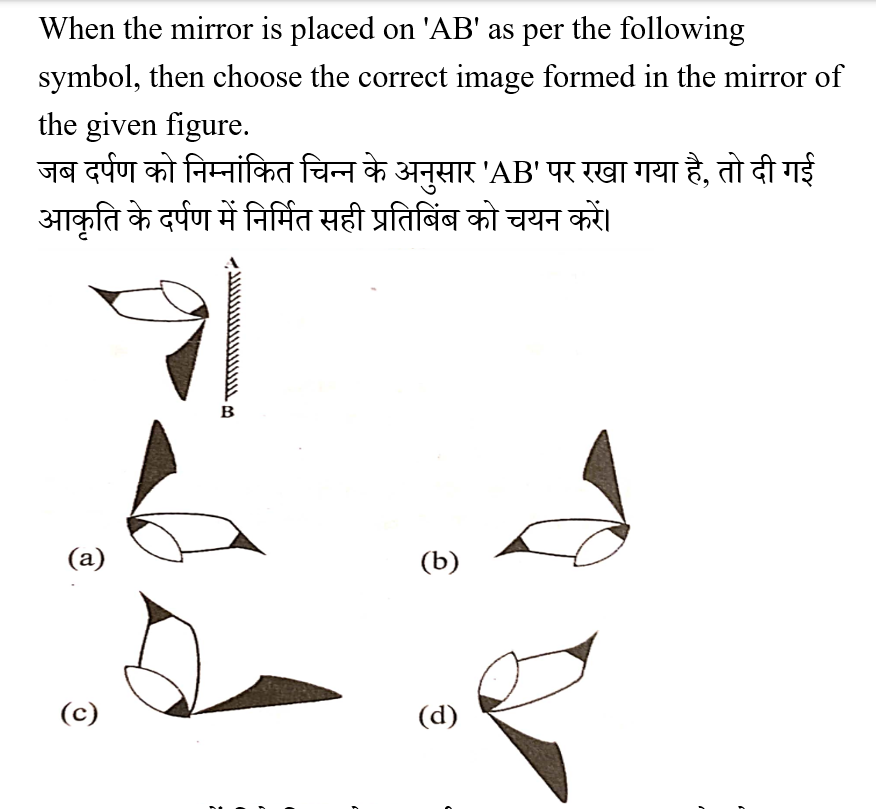Question 1:
The following sentence has been divided into parts that contains an error.Select the part that contains the error from the given options.
Our new secretary's performance have been quite impressive.
Question 2: 
Question 3:
Select the option which has the same relation with the third number as the second number has with the first number.
उस विकल्प का चयन कीजिए जिसका तीसरी संख्या से वही संबंध है, जो दूसरी संख्या का पहली संख्या से है।
68: 19: 164: ?
Question 4:
Direction :- Select the most appropriate option to substitute the underline/Bold segment in the given sentence. If there is no need to improve it, select 'no improvement required'.
Jeremy does not like to discuss his personnel problems openly.
Question 5:
Direction :- Select the most appropriate option to fill in the blank.
Even though we found ourselves in a __________ situation during our climb, we decided not to give up the expedition.
Question 6:
Direction :- Select the most appropriate option to fill in the blank.
In our metro cities the contrast between the high rise buildings with the slums behind is _____________.
Question 7:
Direction :- In the following passage, some words have been deleted. Read the passage carefully and select the most appropriate option to fill in each blank.
The soft layer of the earth's (1) _________ on which plants grow is referred to as soil. Soil includes a huge amount of both organic and inorganic (2) ___________. In the soil, the organic components known as humus are formed from (3) __________plant and animal remnants. These are combined with weathered particles of various rocks to form soil. Weathering occurs as a result of different chemical and physical (4) __________ that occur on the earth's surface. Soil formation is a (5) _________ process in general. For example, the creation of a 2.5 cm thick soil layer might take more than 1000 years.
1.
Question 8:
Direction :- In the following passage, some words have been deleted. Read the passage carefully and select the most appropriate option to fill in each blank.
The soft layer of the earth's (1) _________ on which plants grow is referred to as soil. Soil includes a huge amount of both organic and inorganic (2) ___________. In the soil, the organic components known as humus are formed from (3) __________plant and animal remnants. These are combined with weathered particles of various rocks to form soil. Weathering occurs as a result of different chemical and physical (4) __________ that occur on the earth's surface. Soil formation is a (5) _________ process in general. For example, the creation of a 2.5 cm thick soil layer might take more than 1000 years.
2.
Question 9:
Direction :- In the following passage, some words have been deleted. Read the passage carefully and select the most appropriate option to fill in each blank.
The soft layer of the earth's (1) _________ on which plants grow is referred to as soil. Soil includes a huge amount of both organic and inorganic (2) ___________. In the soil, the organic components known as humus are formed from (3) __________plant and animal remnants. These are combined with weathered particles of various rocks to form soil. Weathering occurs as a result of different chemical and physical (4) __________ that occur on the earth's surface. Soil formation is a (5) _________ process in general. For example, the creation of a 2.5 cm thick soil layer might take more than 1000 years.
3.
Question 10:
Direction :- In the following passage, some words have been deleted. Read the passage carefully and select the most appropriate option to fill in each blank.
The soft layer of the earth's (1) _________ on which plants grow is referred to as soil. Soil includes a huge amount of both organic and inorganic (2) ___________. In the soil, the organic components known as humus are formed from (3) __________plant and animal remnants. These are combined with weathered particles of various rocks to form soil. Weathering occurs as a result of different chemical and physical (4) __________ that occur on the earth's surface. Soil formation is a (5) _________ process in general. For example, the creation of a 2.5 cm thick soil layer might take more than 1000 years.
4.
